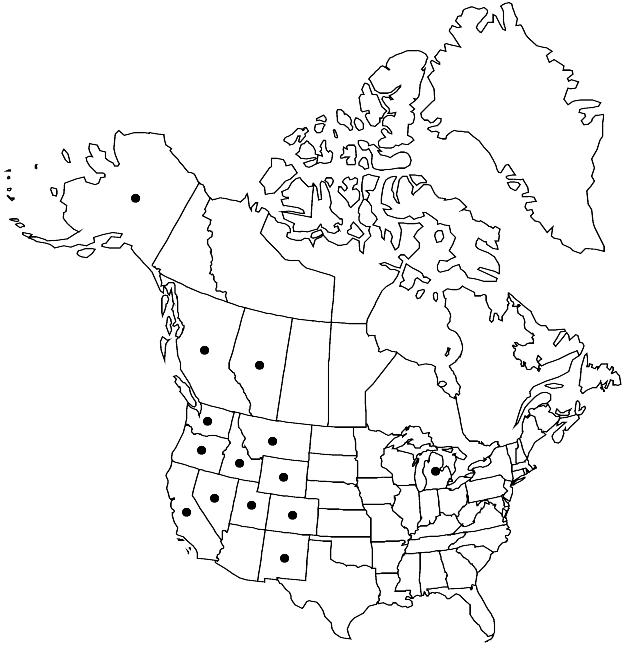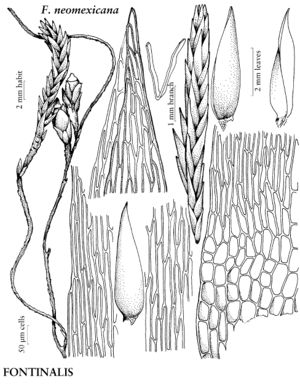Fontinalis neomexicana
in W. S. Sullivant, Musc. Hepat. U.S., 224b. 1856.
Plants to 50 cm, pale green, green, yellowish green, or golden brown. Stems slender to medium, rigid; stem and branch apices stiff, long-attenuate; axillary hairs 300–450 µm, 5–7 cells, basal cell quadrate, red, distal cells long-cylindric, hyaline. Leaves monomorphic, erect-spreading to spreading when dry, erect-spreading in 3 ranks when moist, oblong-lanceolate to ovate-lanceolate, keeled and conduplicate, 2–4(–5) mm; margins sometimes loosely reflexed when dry, plane when moist; apex acute or occasionally subobtuse; medial laminal cells 120–180 × 4–8 µm. Perigonia with leaves 1.3–1.5 mm. Perichaetia with leaves oval to suborbiculate, 3–3.5 mm, apex abruptly apiculate to cuspidate. Seta 0.2–0.3 mm. Capsule immersed to slightly emergent, ovoid to oblong, 2–2.5 mm; operculum obtuse-conic, 0.6–0.9 mm; endostome trellis perfect. Calyptra 2 mm. Spores 15–25 µm.
Habitat: Rock, boulders, sticks, streams
Elevation: low to high elevations (0-3400 m)
Distribution

Alta., B.C., Alaska, Calif., Colo., Idaho, Mich., Mont., Nev., N.Mex., Oreg., Utah, Wash., Wyo.
Discussion
Fontinalis neomexicana is a slender species with monomorphic, keeled leaves, narrow laminal cells, mostly entire leaf margins, and characteristically apiculate to cuspidate perichaetial leaves. Leaf keels beyond the basal curve vary from nearly straight to moderately curved. Fontinalis neomexicana is often found in shallow, fast moving streams. Wet plants are triangular-imbricate, with firm, long-attenuate, sharply three-angled stem and branch apices; dry plants often have erect-spreading to spreading, distinctly three-ranked leaves with loosely reflexed margins. These features appear accentuated by and are correlated with strong stream currents. In slow moving streams, F. neomexicana has loosely foliate stems and somewhat lax, short-attenuate stem and branch apices.
The imbricate form of Fontinalis neomexicana is similar to F. dalecarlica; both species have attenuate stem and branch apices. They are sometimes confused because dry leaves of F. neomexicana can appear concave rather than keeled. Wet plants of F. neomexicana differ from F. dalecarlica in having keeled leaves and angled, rather than terete, stem and branch apices. Slender forms of F. antipyretica (gracilis expression) closely approach the loosely foliate form of F. neomexicana; however, the former have lax to flaccid stems, weakly keeled (often concave) leaves, broader laminal cells (10–12 versus 4–8 µm wide), short, swollen stem and branch apices, and obtuse perichaetial leaves.
Selected References
None.
